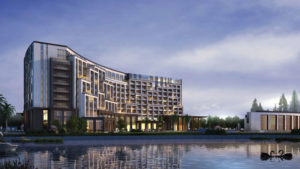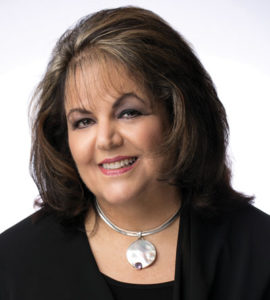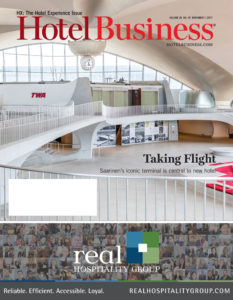NATIONAL REPORT—The momentum behind the boutique hotel segment continues. These properties are seeking out new ways to market through social channels and are leveraging emerging technologies to keep guests entertained, but performance numbers vary depending on subcategory.
“Growth in the boutique hotel segment has mirrored an increasing traveler desire to seek out unique hotels with a true sense of place, and facilities and amenities that are representative of the destination and the local culture,” said Brandon Feighner, director at CBRE Hotels’ Consulting.
The year-end 2017 forecast performance for boutique and lifestyle hotels varies significantly by segment subcategory. The boutique hotel sector in the United States can be broken down into four categories: legacy brands, soft brands, referral and independents, and boutique/lifestyle brands.
“Beyond being a point of differentiation to traditional branded hotels, as boutique hotels gain a wider acceptance and are able to market themselves effectively through social media and emerging technologies, hoteliers are seeing growth opportunities in secondary and tertiary markets that would have been uncommon in the last cycle,” he said.
Legacy brands, according to CBRE, will face greater levels of competition in 2017, which is why this particular segment is forecast to suffer a second consecutive year of declining RevPAR. CBRE projects a 1.9% year-end decrease in this market. ADR and occupancy are both expected to drop 1.5% and 0.5%, respectively. The research firm included the following brands in this particular category: Aloft Hotels, Andaz, Hotel Indigo, Kimpton Hotels & Restaurants and W Hotels.
“As the demand for boutique accommodations grows, all or nearly all of the major brands have entered the market with potentially competitive or soft brands of their own,” said Feighner. “Going forward, regardless of whether hotels are independent boutiques or brand affiliates, the prevailing trend will be a continued and further commoditization of the entire hotel experience.”
Soft brands (brands and affiliations included were Ascend Hotel Collection, Autograph Collection Hotels, Curio Collection by Hilton, The Luxury Collection and Tribute Portfolio) will see the greatest gains in RevPAR in 2017. CBRE projects an increase of 3.4% in this segment at year-end. “Soft-branded boutique properties are forecast to achieve great increases in RevPAR in 2017 and 2018 as compared to the other boutique categories given that they represent a collection of somewhat more affordable hotels within the larger boutique segment, according to our classifications,” Feighner said. This collection tends to capture more leisure guests and fewer commercial travelers, he said.
“In 2018, soft brands are forecast to achieve the largest ADR gains as they represent a relatively more affordable entry point into the boutique sector, but are projected to decline in occupancy at a greater level than the other boutique categories, given an influx of new supply, both in terms of like-kind boutique products and generally in the major metropolitan areas in which they are located,” Feighner said.
Soft brands are expected to see a 2.5% increase in ADR in 2018. Also in the green, RevPAR is projected to grow 1.9% during the same time period.
Independent and referral group boutique hotels are projected to achieve the greatest ADR rates in 2017, according to CBRE. “As a class, these hotels have fully recovered from the recession and are essentially operating at or near a stabilized level of occupancy; thus, any gains in RevPAR will be achieved through ADR growth,” he said. According to CBRE’s research report, this particular segment is forecast to see a 1.8% increase in RevPAR by year-end 2017. CBRE included the following in this category: Historic Hotels of America, The Leading Hotels of the World, Preferred Hotels & Resorts, Small Luxury Hotels of the World and Worldhotels.
For year-end 2018, the research firm is forecasting this segment to see a jump in RevPAR by 3% and an increase in ADR by 1.4%. Occupancy during the same time period is expected to increase slightly, by only 1.1%.
As far as boutique/lifestyle brands are concerned (CBRE included the Affinia Hotel Collection, Joie De Vivre, NYLO Hotels, Thompson Hotels and Valencia Group), a modest decrease in RevPAR (1.4%) is expected. According to CBRE’s “Boutique and Lifestyle Hotels” report, ADR in this segment is not expected to offset the decline in occupancy. For year-end 2017, ADR is expected to increase by 0.6%, with an occupancy decrease of 2%. This market’s RevPAR in 2018 is projected to grow by 2.8%, along with its ADR (1.7%) and occupancy (1.1%).
In the U.S. active pipeline (as of July 2017), legacy brands have 161 properties with 24,716 rooms; soft brands have 95 properties with 13,319 rooms; referral and independents have 33 properties with 3,583 rooms; and boutique/lifestyle brands have 17 properties with 3,187 rooms.
Properties in the boutique hotel sector are known for their design and aesthetics. “Design is always changing,” said Frances Kiradjian, founder and CEO of The Boutique & Lifestyle Lodging Association (BLLA). “However, faced with dominant consumers who crave an experience, boutique hotels are doing more with public space than room interiors, realizing that today’s traveler spends more time in public than in private.” She expects future dollars to be spent on marrying F&B and nightlife with “easy access venues and experiences.”
One of the challenges that properties in the boutique hotel sector face is outsiders who claim they’re “boutique,” something BLLA has been taking on. “Other challenges continue to include finding the right sources of capital, as the marketplace is constantly changing and capital is loosening up for independent hotels; however, you need to know who, what and when to move swiftly and efficiently,” Kiradjian said. Boutique properties are also presented with the challenge of ensuring their distribution methodology includes moving the majority of bookings to direct sources.
“Even a few percentage points drops revenue right to the bottom line,” she said. “Marketing, advertising and social media spend needs to be significantly increased and figured out, and owners/general managers need to be more involved than ever before. This will be one of the secrets to tomorrow’s success.”
“Guests are drawn to boutique hotels for numerous reasons, including everything from the unique architecture and design of a property to the array of local food and beverage offerings featured at the hotel’s restaurant lounge or rooftop,” Feighner said. “While the legacy brands are moving in this direction to a degree, boutique hotels have been at the forefront of delivering unique guest experiences and will continue to do so given their high degree of familiarity with the segment and their ability to evolve with ever-changing trends.” HB



